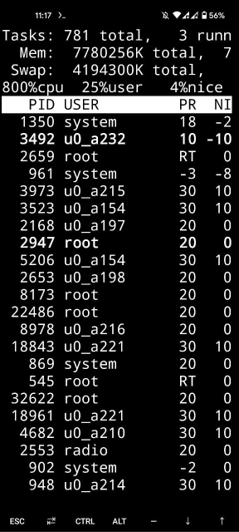前言
本文基于Android 4.19 Kernel展开讨论,使用的二进制文件来自Android Toybox,可能与真正的Linux系统略有不同
本文探究的主要内容
- 内核空间是如何接收用户传来的优先级的
- 优先级在Linux Kernel中的存储方式
- Top命令中PR、NI两个优先级的含义及其在内核中的对应
前情提要
调度策略概述
Linux内核中存在以下几种任务调度策略
include/uapi/linux/sched.h
/*
* Scheduling policies
*/
#define SCHED_NORMAL 0
#define SCHED_FIFO 1
#define SCHED_RR 2
#define SCHED_BATCH 3
/* SCHED_ISO: reserved but not implemented yet */
#define SCHED_IDLE 5
#define SCHED_DEADLINE 6
其中比较稳定和常用的是SCHED_NORMAL、SCHED_FIFO和SCHED_RRSCHED_NORMAL在用户空间有对应的别名SCHED_OTHER,这个名字被使用在如chrt之类的改变调度策略的命令中
其中,SCHED_OTHER是基于CFS算法的时间片轮转,而SCHED_FIFO和SCHED_RR则是实时(RT)调度策略
实时调度策略的优先级始终高于SCHED_OTHER
此处可以引入RT优先级的概念便于理解(对应chrt中的scheduling_priority、内核中的rt_priority)
(一个任务的rt优先级可以直接使用chrt -p <pid>查看到)
可以认为,RT优先级高的任务可以抢占RT优先级低的任务,此处的抢占是指:高优先级的任务不完成,低优先级任务就无法运行
而SCHED_FIFO和SCHED_RR的RT优先级范围是[1,99],SCHED_OTHER的RT优先级必须为0,因此RT任务可以抢占普通任务
对于RT优先级相同(>0)的任务,SCHED_FIFO采用先进先出的策略,而SCHED_RR则采用平均的时间片轮转
(以上阐述是符合用户侧的状态且易于理解的,但rt优先级在内核侧的工作方式可能并没有想的那么简单,因为它并不会直接决定实时任务能抢占普通任务,而且在内核中实时任务的rt优先级是可以为0的,这和用户空间规定的[1,99]确实不同)
CFS算法
上面提到了:SCHED_OTHER是基于CFS算法的时间片轮转
而CFS算法则是一种在时间片轮转过程中,能针对不同进程的CFS优先级,对时间片长短进行偏置的方式
此处的CFS优先级和上述的RT优先级是完全不一样的概念,RT优先级意味着完全的抢占,而CFS优先级则是建立在进程都能运行的前提下
因此,CFS优先级只对具有相同RT优先级的进程有意义,CFS算法只存在于SCHED_OTHER中,此时所有进程的RT优先级均为0
而这个CFS优先级,它有个真正的名字,叫NICE值
在Linux内核中,可以通过以下这个数组将NICE值转换为权重
const int sched_prio_to_weight[40] = {
/* -20 */ 88761, 71755, 56483, 46273, 36291,
/* -15 */ 29154, 23254, 18705, 14949, 11916,
/* -10 */ 9548, 7620, 6100, 4904, 3906,
/* -5 */ 3121, 2501, 1991, 1586, 1277,
/* 0 */ 1024, 820, 655, 526, 423,
/* 5 */ 335, 272, 215, 172, 137,
/* 10 */ 110, 87, 70, 56, 45,
/* 15 */ 36, 29, 23, 18, 15,
};然后再通过下面这条公式,算出允许的进程负载
上面这堆数值带来的规律是,对于两个进程来说,每提升1的NICE值,会使进程能取得的CPU时间减少10%
优先级的修改
用户空间可以使用chrt修改进程的调度策略和RT优先级renice修改进程的CFS NICE值
内核空间可以使用int sched_setscheduler(struct task_struct *p, int policy, const struct sched_param *param)修改进程调度策略和实时优先级void set_user_nice(struct task_struct *p, long nice)修改进程的NICE值
正文
以下内容才是这篇文章探究的关键点
优先级在内核侧的存储
在Linux关键的PCB中,存在以下内容
include/linux/sched.h
struct task_struct {
......
int prio;
int static_prio;
int normal_prio;
unsigned int rt_priority;
unsigned int policy;
......
};其中包含了各种优先级和调度策略,接下来就逐一探究其存储了什么内容
NICE值
直接从设置NICE值的函数入手,看看东西被存到了哪里
kernel/sched/core.c
void set_user_nice(struct task_struct *p, long nice)
{
bool queued, running;
int old_prio, delta;
struct rq_flags rf;
struct rq *rq;
if (task_nice(p) == nice || nice < MIN_NICE || nice > MAX_NICE)
return;
/*
* We have to be careful, if called from sys_setpriority(),
* the task might be in the middle of scheduling on another CPU.
*/
rq = task_rq_lock(p, &rf);
update_rq_clock(rq);
/*
* The RT priorities are set via sched_setscheduler(), but we still
* allow the 'normal' nice value to be set - but as expected
* it wont have any effect on scheduling until the task is
* SCHED_DEADLINE, SCHED_FIFO or SCHED_RR:
*/
if (task_has_dl_policy(p) || task_has_rt_policy(p)) {
p->static_prio = NICE_TO_PRIO(nice);
goto out_unlock;
}
queued = task_on_rq_queued(p);
running = task_current(rq, p);
if (queued)
dequeue_task(rq, p, DEQUEUE_SAVE | DEQUEUE_NOCLOCK);
if (running)
put_prev_task(rq, p);
p->static_prio = NICE_TO_PRIO(nice);
set_load_weight(p, true);
old_prio = p->prio;
p->prio = effective_prio(p);
delta = p->prio - old_prio;
if (queued) {
enqueue_task(rq, p, ENQUEUE_RESTORE | ENQUEUE_NOCLOCK);
/*
* If the task increased its priority or is running and
* lowered its priority, then reschedule its CPU:
*/
if (delta < 0 || (delta > 0 && task_running(rq, p)))
resched_curr(rq);
}
if (running)
set_curr_task(rq, p);
out_unlock:
task_rq_unlock(rq, p, &rf);
}
EXPORT_SYMBOL(set_user_nice);可以看到,无论是RT进程还是普通进程,最终nice值都通过了一个NICE_TO_PRIO的宏,存储到了static_prio中
而这个宏是长这样的
include/linux/sched/prio.h
#define MAX_NICE 19
#define MIN_NICE -20
#define NICE_WIDTH (MAX_NICE - MIN_NICE + 1)
/*
* Priority of a process goes from 0..MAX_PRIO-1, valid RT
* priority is 0..MAX_RT_PRIO-1, and SCHED_NORMAL/SCHED_BATCH
* tasks are in the range MAX_RT_PRIO..MAX_PRIO-1. Priority
* values are inverted: lower p->prio value means higher priority.
*
* The MAX_USER_RT_PRIO value allows the actual maximum
* RT priority to be separate from the value exported to
* user-space. This allows kernel threads to set their
* priority to a value higher than any user task. Note:
* MAX_RT_PRIO must not be smaller than MAX_USER_RT_PRIO.
*/
#define MAX_USER_RT_PRIO 100
#define MAX_RT_PRIO MAX_USER_RT_PRIO
#define MAX_PRIO (MAX_RT_PRIO + NICE_WIDTH)
#define DEFAULT_PRIO (MAX_RT_PRIO + NICE_WIDTH / 2)
/*
* Convert user-nice values [ -20 ... 0 ... 19 ]
* to static priority [ MAX_RT_PRIO..MAX_PRIO-1 ],
* and back.
*/
#define NICE_TO_PRIO(nice) ((nice) + DEFAULT_PRIO)翻译一下就是,static_prio = 120 + nice
此时我们已经明白,对于任何任务,即使是NICE值无效的RT任务,其NICE值也会在换算后被存储到static_prio中
rt_priority
static void __setscheduler_params(struct task_struct *p,
const struct sched_attr *attr)
{
int policy = attr->sched_policy;
if (policy == SETPARAM_POLICY)
policy = p->policy;
/* Replace SCHED_FIFO with SCHED_RR to reduce latency */
p->policy = policy == SCHED_FIFO ? SCHED_RR : policy;
if (dl_policy(policy))
__setparam_dl(p, attr);
else if (fair_policy(policy))
p->static_prio = NICE_TO_PRIO(attr->sched_nice);
/*
* __sched_setscheduler() ensures attr->sched_priority == 0 when
* !rt_policy. Always setting this ensures that things like
* getparam()/getattr() don't report silly values for !rt tasks.
*/
p->rt_priority = attr->sched_priority;
p->normal_prio = normal_prio(p);
set_load_weight(p, true);
}rt_priority就是来自于sched_setscheduler中传递的param中的sched_priority,而这又对应到了syscall使用的sys_sched_setscheduler,也就是说,上方的两条设置rt优先级的命令,都将rt优先级赋值给了rt_priority,其值与赋值的值相等
normal_prio
normal不是普通,而是normalize的缩写
这个东西被称为归一化的优先级,也就是说,这个东西存在的意义主要在于,使得不同调度策略的任务在优先级上能够方便的比较
而它,其实就是通过一种算法,把RT优先级和NICE值两者融合在了一起,为所有任务呈现一个通用的优先级
include/linux/sched/prio.h
#define MAX_NICE 19
#define MIN_NICE -20
#define NICE_WIDTH (MAX_NICE - MIN_NICE + 1)
/*
* Priority of a process goes from 0..MAX_PRIO-1, valid RT
* priority is 0..MAX_RT_PRIO-1, and SCHED_NORMAL/SCHED_BATCH
* tasks are in the range MAX_RT_PRIO..MAX_PRIO-1. Priority
* values are inverted: lower p->prio value means higher priority.
*
* The MAX_USER_RT_PRIO value allows the actual maximum
* RT priority to be separate from the value exported to
* user-space. This allows kernel threads to set their
* priority to a value higher than any user task. Note:
* MAX_RT_PRIO must not be smaller than MAX_USER_RT_PRIO.
*/
#define MAX_USER_RT_PRIO 100
#define MAX_RT_PRIO MAX_USER_RT_PRIO
#define MAX_PRIO (MAX_RT_PRIO + NICE_WIDTH)
#define DEFAULT_PRIO (MAX_RT_PRIO + NICE_WIDTH / 2)
/*
* Convert user-nice values [ -20 ... 0 ... 19 ]
* to static priority [ MAX_RT_PRIO..MAX_PRIO-1 ],
* and back.
*/
#define NICE_TO_PRIO(nice) ((nice) + DEFAULT_PRIO)
include/linux/sched/deadline.h
/*
* SCHED_DEADLINE tasks has negative priorities, reflecting
* the fact that any of them has higher prio than RT and
* NORMAL/BATCH tasks.
*/
#define MAX_DL_PRIO 0
kernel/sched/core.c
/*
* __normal_prio - return the priority that is based on the static prio
*/
static inline int __normal_prio(struct task_struct *p)
{
return p->static_prio;
}
/*
* Calculate the expected normal priority: i.e. priority
* without taking RT-inheritance into account. Might be
* boosted by interactivity modifiers. Changes upon fork,
* setprio syscalls, and whenever the interactivity
* estimator recalculates.
*/
static inline int normal_prio(struct task_struct *p)
{
int prio;
if (task_has_dl_policy(p))
prio = MAX_DL_PRIO-1;
else if (task_has_rt_policy(p))
prio = MAX_RT_PRIO-1 - p->rt_priority;
else
prio = __normal_prio(p);
return prio;
}从上面这段代码中可以看到,对于SCHED_OTHER类型的任务,其normal_prio就是static_prio
而对于RT类型的任务,其normal_prio为99-rt_priority
在于RT任务的优先级范围[0,99]对照之后
我们可以得出下方的结论
normal_prio的分布是连续的,其中区间[0,99]属于RT任务,大小由RT优先级决定
[100,139]属于普通任务,大小由NICE值决定
嗯?有没有发现奇怪的地方,为什么99是闭区间呢?RT任务的RT优先级的范围不是从1开始的么,这我在上面有提到过,内核中任务的RT优先级是可以被设置为0的,即使用户空间并不允许这么做
prio
别忘了task_struct里面还有个就叫做prio的东西
这个东西有另一个叫法:effective_prio 有效优先级
这个东西似乎是RT任务调度优先的真正参考依据,而不是rt_priority
rt.c:274: return rq->rt.highest_prio.curr > prev->prio &&
rt.c:386: plist_node_init(&p->pushable_tasks, p->prio);
rt.c:390: if (p->prio < rq->rt.highest_prio.next)
rt.c:391: rq->rt.highest_prio.next = p->prio;
rt.c:402: rq->rt.highest_prio.next = p->prio;
rt.c:511: if (rt_rq->highest_prio.curr < curr->prio)
rt.c:546: return p->prio != p->normal_prio;
rt.c:914: return rt_task_of(rt_se)->prio;
rt.c:1542: curr->prio <= p->prio))) {
rt.c:1553: p->prio < cpu_rq(target)->rt.highest_prio.curr))
rt.c:1596: if (p->prio < rq->curr->prio) {
rt.c:1614: if (p->prio == rq->curr->prio && !test_tsk_need_resched(rq->curr))
rt.c:1960: if (lowest_rq->rt.highest_prio.curr <= task->prio) {
rt.c:1991: if (lowest_rq->rt.highest_prio.curr > task->prio)
rt.c:2051: if (unlikely(next_task->prio < rq->curr->prio)) {
rt.c:2351: if (p && (p->prio < this_rq->rt.highest_prio.curr)) {
rt.c:2363: if (p->prio < src_rq->curr->prio)
rt.c:2399: rq->curr->prio <= p->prio))
rt.c:2475: if (p->prio < rq->curr->prio && cpu_online(cpu_of(rq)))
rt.c:2496: if (oldprio < p->prio)
rt.c:2503: if (p->prio > rq->rt.highest_prio.curr)
rt.c:2507: if (oldprio < p->prio)
rt.c:2516: if (p->prio < rq->curr->prio)据说是因为一些普通任务在某些情况下也会被boost成RT类型的任务?
/*
* Calculate the current priority, i.e. the priority
* taken into account by the scheduler. This value might
* be boosted by RT tasks, or might be boosted by
* interactivity modifiers. Will be RT if the task got
* RT-boosted. If not then it returns p->normal_prio.
*/
static int effective_prio(struct task_struct *p)
{
p->normal_prio = normal_prio(p);
/*
* If we are RT tasks or we were boosted to RT priority,
* keep the priority unchanged. Otherwise, update priority
* to the normal priority:
*/
if (!rt_prio(p->prio))
return p->normal_prio;
return p->prio;
}不过按照这东西的生成方法来看,大多数情况下,它都是和normal_prio保持一致的
TOP命令中的优先级
NI很明显是NICE值,那PR又是什么,看这个范围,好像啥也不是,有时甚至还会出现字符串RT?
此处忽略实验过程,直接说结论
NI = normal_prio - 100
不过也有可能是prio - 100,不过这俩东西基本都是相等的,我也不知道到底是哪个
当NI<=-10时,TOP中显示为RT,并不是网上有些说法中所谓的最优先才显示为RT
结
至于这些优先级在内核中具体被使用的方式,有待进一步研究


